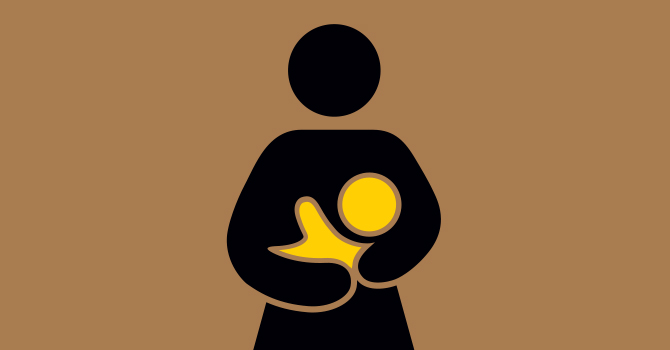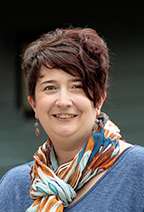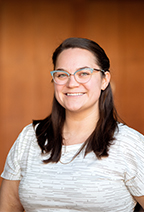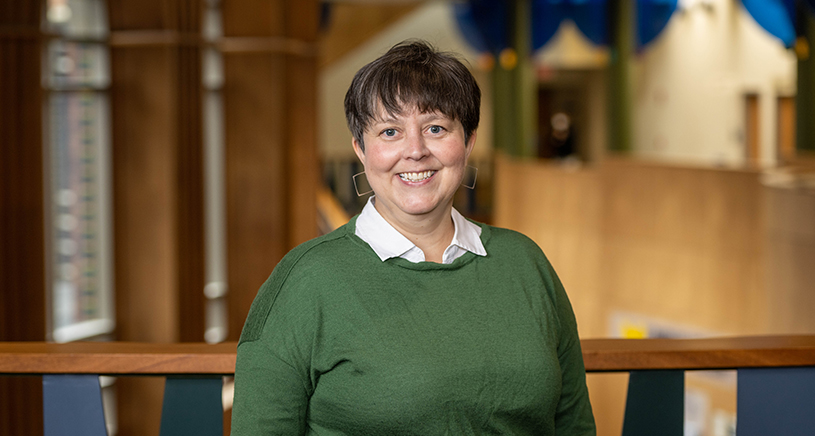Maternal Health: Improving Well-Being for Moms and Babies

Women think about more than just the pain they may experience during childbirth. They think about the many factors—both environmental and social—that can impact health outcomes for themselves and their children. Experts from the University of Michigan School of Public Health and the School of Nursing discuss how these social factors, environmental exposures, and maternal support can contribute to the overall well-being of moms and babies.
Listen to "Maternal Health: Improving Well-Being for Moms and Babies" on Spreaker.
|
Subscribe and listen to Population Healthy on Apple Podcasts, Spotify, Google Podcasts, iHeartRadio, YouTube or wherever you listen to podcasts! Be sure to follow us at @umichsph on Twitter, Instagram, and Facebook, so you can share your perspectives on the issues we discussed, learn more from Michigan Public Health experts, and share episodes of the podcast with your friends on social media. |
[music]
00:17 Lee Roosevelt: Being a nurse midwife is I think, one of the most incredible and amazing jobs I could think of. It's a really miraculous event to get to bear witness to the creation of a family. I have attended various of people having their ninth, 12th baby and it's just as miraculous and amazing because it's the only time that this particular baby will be born. When I was in midwifery school I worked with a lot of older people in hospice care, and people that couldn't remember their kids' names or couldn't remember what they had eaten, or what was going on or where they are or who they where. If you asked them about their birth story, they could always remember how they gave birth. That that was the memory that stayed with them for their whole life and they would give details about it that you would be shocked that they would remember given what their current memory status was. And so our role as providers, like that's so key. This is a story that a woman is gonna remember for the rest of her entire life and take meaning from.
01:29 Narrator: Hello and welcome to Population Healthy, a podcast from the University of Michigan School of Public Health. Join us as we dig into important public health topics, stuff that affects the health of all of us, at a population level, from the microscopic to the macroeconomic, the social to the environmental, from neighborhoods to cities, states to countries and around the world.
[music]
02:02 Narrator: Today, we're talking about the many factors, both environmental and social, that can impact the health of pregnant women and unborn children. We'll explore four different dimensions from public health experts who are working to keep women and their babies healthy. Lee Roosevelt is a Clinical Assistant Professor at the University of Michigan School of Nursing and an alumna of the University of Michigan School of Public Health. She has also delivered hundreds of babies in her role as a nurse-midwife.
02:29 LR: The misnomer around morbidity and mortality in the United States is that it's growing. Overall, what's really happening is some groups are staying very stable and for some groups, their outcomes are getting worse and it's a result of the outcomes, getting worse around particularly people that are marginalized in some way within the healthcare system. If I talk to midwives that have been catching babies for the past 25, 30 years, all of us will say, "Things look different now. People are sicker." The rate of sort of normal, healthy uncomplicated birth. We just don't see it as much as we used to. And I don't think that that's grounded solely in an individual person's health, overall. I think that there are larger structures at play that are contributing to that overall shift that all of us as providers are seeing. It isn't that the sicker people are then getting more sick in labor, it's people that are overall healthy are getting sicker during pregnancy and during birth as well. And whenever you have that aspect of where you're seeing across the board, increased morbidity you have to look at larger structures. You can't pinpoint it on, "Well, people are heavier or people have more diabetes or people have more heart disease." Yes, maybe all of that is true, too, but that's not the only thing that's going on.
[music]
04:04 LR: We have this narrative that a lot of people when they think about fear of childbirth and they think about the pain and they think about if it's gonna hurt or if they are gonna die or if the baby's gonna die. And some of the research that I've done, sort of looking at communities that don't often have voices around their experiences around birth, that their fears are a little bit more complex. Their fears are, if they're gonna be treated with respect by their providers. Are their providers gonna listen to them? Are they gonna treat them the same way that they've treated every other birthing person that day? And those fears are more grounded in, I think a lot of provider bias and the fears that people experience are really grounded and worrying about how those biases are gonna affect their labor and birth.
04:52 LR: The reality for a woman of color going into a birthing experience may be very different than the experience of a white woman going into birth. I think a lot about just the patients that come in every day that feel like they have a space and acknowledge that this was the first sort of provider space that they've been in where they were allowed to vent about a racist encounter that they had at the grocery store earlier, and that their care provider talked about it in terms of the context of how that impacts her pregnancy overall that, that continual exposure to the sort of micro-aggressions of racism or classism or homophobia or whatever the little assaults are that we, as providers, are acknowledging that those are meaningful and not just meaningful and that they're emotionally significant, but meaningful in terms of they have an influence of how healthy, she is able to keep herself during pregnancy.
[music]
05:58 Narrator: Arline Geronimus is a professor of Health Behavior and Health Education at the University of Michigan School of Public Health. Early in her career, she coined the term weathering to describe how marginalized populations are much more susceptible to early health declines due to the ongoing physical and psychological effects of dealing with social inequity. While weathering can affect anyone in a marginalized group, the potential health issues for pregnant women and their babies are significant.
06:23 Arline Geronimus: Weathering is a structurally rooted biopsychosocial process reflective of how life circumstances and experiences promote or undermine health on a population level, as individuals grow in age. The idea is that the accumulation of an high effort coping with material hardship, social exclusion, exposure to toxic environmental challenges, and prolonged cognitive and emotional engagement toward overcoming social injustice and material disadvantage result in stress-mediated wear and tear across body systems, the neuro-endocrine, the cardiovascular, the metabolic and the immune systems. So, in this framework, people's health reflects the cumulative impact of their lived experiences, at least from conception to their current age. The older they are, the more time they've had to have health impacting experiences and the greater the opportunity for these experiences to express any health effects, or to accumulate or interact with others. In other words, when comparing the health of more and less privileged groups, 20 does not equal 20, 30 is even less likely to equal 30, and so on. Being chronically stressed can literally accelerate the aging of your cells.
07:39 AG: I first began to think about what I would come to call weathering when I was in college in the mid-1970s I worked part-time at a school, and clinic for pregnant teenagers in Trenton, New Jersey, which was a working class city with a large population of color, and I noticed that the teenagers in Trenton, suffered from chronic health conditions that were unheard of in my generally better off and less diverse group of Princeton classmates of about the same age, but no one was talking about this. In fact, the conventional wisdom at that time was at late teen years and early 20s were the beginning of the health prime of life and that chronic diseases didn't develop until middle age. I began to wonder both what accounted for this early health deterioration among the young women in Trenton relative to Princeton and whether that might be linked to the earlier childbearing of the Trenton teens.
08:36 AG: I focused on the relationship between maternal age and adverse birth outcome to my dissertation. And I found that in contrast to accepted belief that there are universally healthier and less healthy ages to bear children, the teenagers were assumed universally to be unhealthy ages for child-bearing, I found instead that different populations within the United States, such as by racial ethnic group or poverty status, or urban or rural or suburban residents had different trajectories of what constituted their higher or lower risk ages for infant mortality and other adverse birth outcomes. In particular, the lowest risk ages for infant mortality in working class populations of color were in the teens.
09:21 AG: Today the idea that there are social determinants of health is widely accepted and studies of it abound. But at the time I did my dissertation, that was not true and the mainstream public health idea was we should focus on individual behavioral risk factors and how to change them. There are many ways to address this, including moving forward toward universal health insurance and also addressing the fact of implicit bias among healthcare professionals, that may lead them to not take the concerns of mothers in, or shortly after childbirth, seriously or treat patients of color equitably with other patients when presenting with symptoms of chronic disease.
[music]
10:08 Narrator: Deborah Watkins is a Research Assistant Professor of Environmental Health Sciences at the University of Michigan School of Public Health. Her work identifies environmental exposures that can impact development in utero and into childhood. Surprisingly, some exposures can be found in products that many of us use in our daily lives.
10:26 Deborah Watkins: I focused primarily on exposure to chemical containments, which can be found anywhere from drinking water to personal care products, but environmental exposures can also include stressful events during pregnancy, poverty or other types of environmental factors. Environmental exposures can act through a number of pathways to increase negative health outcomes, including disrupting the endocrine system, changing hormone levels during pregnancy, or increasing or stress. Environmental exposures have been associated with increased risk of pre-term birth both decreased or increased birth weight, depending on the chemical as well as changes in hormone storing pregnancy, which can influence both pregnancy outcomes, and various aspects of child development. Exposure to certain chemicals during in-utero development have been associate with changes in cognition, attention, motor skills as well as social and emotional development.
11:16 DW: Other adverse effects include, changes in glucose and lipid metabolism, BMI, reproductive development, which also has implications for a long-term health. Phthalates are a group of chemicals that are found in a number of different types of consumer products. Phthalates, bisphenol A and other chemicals they can act as endocrine disruptors in the body, meaning they can either act as hormones or they can block the activity of hormones, using certain types of personal care products, particularly ones with fragrance added or eating processed foods or food packed in plastic are both important sources of phthalate exposure. Food is also important source of exposure to pesticides so eating organic, especially for specific foods known to be high and pesticides can really help reduce exposure. In the home, some chemicals can leach from internal electronics into the indoor environment as well as into house dust, so people can be exposed by touching things in the home and then touching their mouth or eating. There's a lots of hand to mouth activity that people aren't really aware of. This is actually really an important source of exposure, particularly in young children as they tend to play on the floor, they crawl around, they put things into their mouths.
[music]
12:25 DW: The Environmental Working Group at ewg.org each year publishes a list of foods that are the highest in pesticides called The Dirty Dozen as well as a list or the lowest in pesticides called the Clean 15. So this is a really good resource. On their website, the Environmental Working Group also has a whole section on children's environmental health with a number of tip sheets for minimizing exposure through lots of different pathways including, cleaning food and personal care products. They have a database for personal care products called Skin Deep. You can put in whatever product that you use, and it comes up with their rating of it, and what ingredients in that product could be potentially hazardous or really beneficial.
13:07 DW: Another excellent resource is the Silent Spring Institute which has an app called Detox Me which also provides tips for minimizing various exposures. So it really is impossible to avoid exposure to many of these chemicals because they really are everywhere, a lot of the chemicals aren't really required to be listed as an ingredient and sometimes the package itself is made out of the chemical, but we don't know that. But there really are some good ways you can minimize exposure, eating fresh fruits and vegetables instead of canned or processed foods, storing and re-heating food in glass rather than plastic containers, avoiding products with parabens, choosing products that have no fragrance added washing hands on a regular basis, especially prior to eating.
[music]
13:55 Narrator: Let's turn now to Brittany McQueer, a health behavior and health education student at the University of Michigan School of Public Health and a practicing doula.
14:02 Brittany McQueer: A doula provides non-medical support during labor birth and postpartum period. And this could be anything that the family may need or want. Something doulas also do is provide continuity of care, or the person who sees mom maybe every day after she's given birth, whereas a doctor won't see them for six weeks is their first appointment. Babies take a long time to come out and doctors wanna push that agenda because they have a lot of babies that have to come out. And having doula available to advocate for you and to help remind you to wait really helps limit the induction rate and it also helps to decrease your need for intervention. You're 31% less likely to use an induction with some type of synthetic oxytocin, and that is a really important role of the doula is trying to wait until an induction is necessary, because that sets off a whole cascade of other interventions that probably will need to be used and for a long labor. Postpartum work is really broad. It could be something as simple as making food for the family, tidying up the house, checking wounds making sure that mom's taking care of herself and helping her decide when it is appropriate to go to the doctor if there's a complication, or something like that.
15:16 Narrator: In addition to working as a doula, Brittany is also a passionate advocate.
15:21 BM: I firmly believe that this should be something that's included in all of our insurance plans and in our medical jargon when we're talking to expectant moms. But accessing a doula isn't always that easy because it costs money and it's not covered by insurance. A birth doula costs about $1,000 and that covers to prenatal visits being on call for your birth, your entire birth experience and then two post-natal visits. And to me, that's a really valuable chunk of time for that amount of money. When you think about the fact that a epidural costs $1,300 an emergency C-section costs $13,000, having this $1,000 of investment in your care by having a doula is a huge cost savings in my mindset. In the state of Minnesota they implemented a state Medicaid program to cover doulas.
16:14 BM: They were able to determine there was a cost savings differential of 22.5% when doulas were used, and this was solely based on evidence that the doulas were able to prevent unnecessary C-section procedures. Doulas are present in the delivery room as a complement to doctors. So it's really important that as a new generation of doulas that we're walking into hospitals with a open mind and a willingness to rebuild relationships with doctors that may have been burnt in the past because we are there not to be doctors, we are there to provide good care for our mamas to be with them throughout the entire experience, so they don't have to go through it alone, and to be able to help them advocate for themselves and their needs.
[music]
17:12 Narrator: Thanks for listening to this episode of Population Healthy from the University of Michigan School of Public Health. We're glad you decided to join us, and we hope you learned something that will help improve your own health or make the world a healthier place. If you enjoyed the show, please subscribe or follow this podcast on iTunes, Apple Podcast, Google Play, Stitcher, Spotify or wherever you listen to podcasts. Be sure to follow us @umichsph on Twitter, Instagram and Facebook, so you can share your perspectives on the issues we discussed, learn more for Michigan Public Health Experts and share episodes of the podcast with your friends on social media. You can also check out the show notes on our website, publichealth.umich.edu/podcast for more resources about the topics discussed in today's episode. If you want to stay up to date with the latest research and expertise from Michigan Public Health, subscribe to our Population Healthy newsletter at publichealth.umich.edu/news/newsletter. We hope you join us for next week's episode where we'll dig further into public health topics that affect all of us at a population level.
In This Episode
 Lee Roosevelt
Lee Roosevelt
Clinical Assistant Professor of Health Behavior and Biological Sciences at the University of Michigan School of Nursing
 Arline Geronimus
Arline Geronimus
Professor of Health Behavior and Health Education at the University of Michigan School of Public Health
Arline Geronimus’s research interests include structural and cultural influences on population variation in family structure and age-at-first birth; the effects of poverty, institutionalized discrimination, and aspects of residential areas on health; the collective strategies marginalized communities employ to mitigate, resist, or undo the harmful effects of poverty and structural racism on their health; the trade-offs these strategies reflect; and the effects of public policies on these autonomous protections. Learn more.
 Brittany McQueer
Brittany McQueer
Master’s Student in Health Behavior and Health Education at the University of Michigan School of Public Health and practicing doula
 Deborah Watkins
Deborah Watkins
Research Assistant Professor of Environmental Health Sciences at the University of Michigan School of Public Health
Deborah Watkin’s research is focused on investigating causal relationships between exposure to environmental contaminants during critical periods of development and subsequent health effects. Specifically, she is interested in the molecular mechanisms by which exposure to endocrine disrupting chemicals may affect hormonally driven developmental processes, such as growth, neurodevelopment, and puberty, with long-term impacts on health. Learn more.
